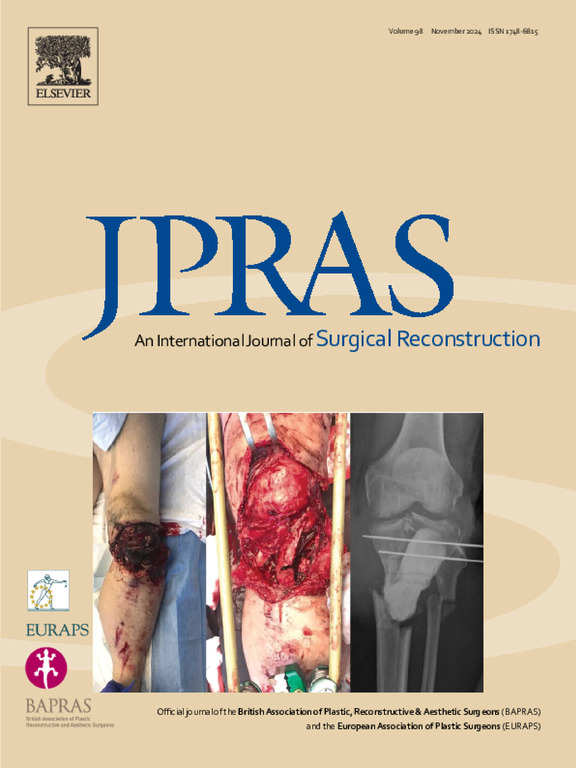The waist-to-hip ratio is a superior predictor of complications in breast reconstruction: A prospective pilot study
IF 2
3区 医学
Q2 SURGERY
Journal of Plastic Reconstructive and Aesthetic Surgery
Pub Date : 2024-09-28
DOI:10.1016/j.bjps.2024.09.076
引用次数: 0
Abstract
Introduction
Breast reconstruction remains common. Identifying the key risk factors for preoperative counseling is key to improving surgical outcomes. The body mass index is a commonly used measure of preoperative risk but remains controversial. We propose that the waist-to-hip ratio, a measure of central adiposity, is superior to the body mass index in predicting complications.
Methods
A single surgeon’s breast reconstruction patients were prospectively analyzed from 2022–2023. Demographic data, medical comorbidities, and surgical variables were recorded, as were complications including infection, wound breakdown, and loss of reconstruction. Height, weight, waist circumference, and hip circumference were collected to calculate the waist-to-hip ratio, waist-to-height ratio, and body surface area. Statistical analysis and multivariate analysis were performed.
Results
One hundred patients were evaluated, 50 for alloplastic and 50 for autologous, abdominally based reconstruction. For alloplastic patients, 26% had complications, with a higher waist-to-hip ratio (0.96 v 0.88). On multivariate regression, the waist-to-hip was the only significant independent predictor of complications. For autologous reconstruction, again 26% had complications, with a higher waist-to-hip ratio (0.96 v 0.88). On multivariate regression, the waist-to-hip was the only significant predictor of complications. For both groups, waist-to-hip did not strongly correlate with other morphometric measures. Age and other morphometric measures were not predictive of complications for either set.
Conclusion
The waist-to-hip ratio is a superior predictor of surgical risk to the body mass index in our cohort and could be integrated in plastic surgery practices to improve outcomes.
Level of evidence
IV
腰臀比是预测乳房再造并发症的最佳指标:前瞻性试验研究。
导言:乳房再造仍然很常见。确定术前咨询的关键风险因素是改善手术效果的关键。体重指数是衡量术前风险的常用指标,但仍存在争议。我们认为,腰臀比作为中心脂肪含量的衡量标准,在预测并发症方面优于体重指数:方法:我们对一位外科医生在 2022-2023 年期间的乳房重建患者进行了前瞻性分析。记录了人口统计学数据、合并症、手术变量以及并发症,包括感染、伤口破裂和重建损失。收集了身高、体重、腰围和臀围,以计算腰臀比、腰高比和体表面积。进行了统计分析和多变量分析:结果:对 100 名患者进行了评估,其中 50 人进行了异体重建,50 人进行了自体腹部重建。异体患者中有 26% 出现并发症,腰臀比(0.96 对 0.88)较高。在多变量回归中,腰臀比是唯一能显著预测并发症的独立因素。对于自体重建,同样有 26% 的患者出现并发症,腰臀比更高(0.96 对 0.88)。在多变量回归中,腰臀比是唯一能显著预测并发症的因素。在两组患者中,腰臀比与其他形态测量指标的相关性并不强。年龄和其他形态测量指标对两组患者的并发症均无预测作用:结论:在我们的队列中,腰臀比是优于体重指数的手术风险预测指标,可纳入整形外科实践以改善手术效果:证据等级:IV。
本文章由计算机程序翻译,如有差异,请以英文原文为准。
求助全文
约1分钟内获得全文
求助全文
来源期刊
CiteScore
3.10
自引率
11.10%
发文量
578
审稿时长
3.5 months
期刊介绍:
JPRAS An International Journal of Surgical Reconstruction is one of the world''s leading international journals, covering all the reconstructive and aesthetic aspects of plastic surgery.
The journal presents the latest surgical procedures with audit and outcome studies of new and established techniques in plastic surgery including: cleft lip and palate and other heads and neck surgery, hand surgery, lower limb trauma, burns, skin cancer, breast surgery and aesthetic surgery.

 求助内容:
求助内容: 应助结果提醒方式:
应助结果提醒方式:


